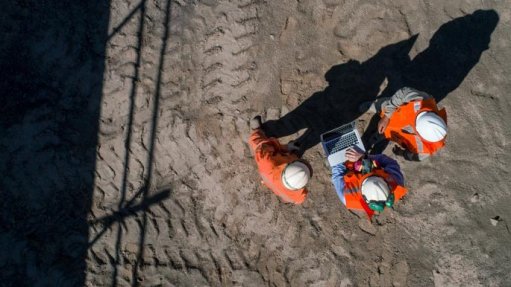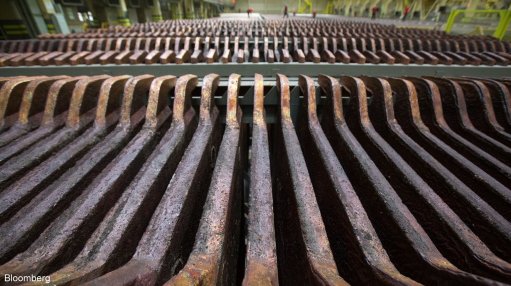Lonmin maintaining FY17 guidance despite weaker Generation 2 shafts production



MARIKANA MINE, NORTH WEST Lonmin’s Marikana mining operations, in the North West, including Pandora, produced 2.3-million tonnes for the three months to December 31
Photo by Bloomberg
GENERATION 2 SHAFTS Produced 1.8-million tonnes, which was 100 000 t, lower than the prior comparative period as K3’s underperformance predominantly weighed down overall performance
Photo by Duane Daws
Platinum producer Lonmin is disappointed by first-quarter production figures at its Generation 2 shafts; however, with the initiative of deploying additional stoping and vamping crews and the expected platinum ounces from the smelter clean-up project, it is maintaining its sales guidance for the 2017 full year at between 650 000 oz and 680 000 oz of platinum.
“At this stage, we still expect unit costs to remain in the range of between R10 800 and R11 300 per platinum-group metal (PGM) ounce for the full year, subject to seeing sustained improvement in production during the year,” Lonmin said in a statement issued last week.
The company’s Marikana mining operations, in the North West, including Pandora, produced 2.3-million tonnes for the three months to December 31 – a 7.8%, or 200 000 t, decrease on production in the three months to December 31, 2015, partly as a result of the planned decline from the closing of the company’s high-cost shafts.
“While the first quarter of our financial year is historically our lowest producing quarter, the mining performance was disappointing, with production at our Generation 2 shafts down 5.2% from the prior year period,” the miner stated.
Lonmin commented that the implementation of initiatives to improve productivity was taking longer than planned, particularly in respect of improving absenteeism. Nonetheless, the company said it remained committed to delivering sustained productivity improvements at its operations to ensure the long-term viability of the business.
The miner remarked that the reduction in Section 54 work stoppages had continued, with tonnes lost owing to Section 54 safety stoppages down by 71% in the quarter.
Generation 2 shafts produced 1.8-million tonnes – 5.2%, or 100 000 t, lower than the prior comparative period as K3’s underperformance predominantly weighed down the overall performance.
“K3, which is our biggest shaft, produced 590 000 t, a disappointing decrease of 13.8% on the prior period. This shaft was most impacted by the reorganisation from 2016 and during the quarter experienced high management-induced safety stoppages resulting in 60 000 t of lost production,” noted Lonmin.
The platinum producer said that, overall, the relationship between operational management and unions at this shaft was not working as effectively as had been expected and the delivery of results from the implementation of business improvement initiatives at the shaft was, therefore, taking longer than intended.
“As a result, we are deploying additional stoping and vamping crews to the shaft to take advantage of the immediately available ore reserves and improve production.”
The company cautioned that this action might have an “adverse impact” on the shaft’s head cost per ton, which the company would seek to mitigate by further reducing its overhead costs.
Moreover, Rowland shaft produced 424 000 t during the quarter, which was an increase of 9.6% on the prior year period, with this shaft now starting to gain the production benefits from improved safety performance. Saffy shaft produced 493 000 t during the quarter, which Lonmin said was broadly in line with the prior year period and demonstrated that the shaft was maintaining its steady-state performance.
Additionally, 4B shaft produced 336 000 t in the period under review, which was a decrease of 10.7% on the prior year period, as a result of a higher-than-planned frequency of intersecting geological features and changes in middle management.
Platinum production (metal-in-concentrate) for the quarter under review was 152 925 oz, which was 8.4% lower than for the prior year period, while PGMs production (metals-in-concentrate) was 292 726 oz, which was 8.6% lower than for the prior year period.
Lonmin explained that this was because it had milled more than it had mined in the prior year period.
Refined platinum production reached 137 123 oz in the quarter, which was 20% lower than for the prior year period.
Further, refined PGMs production was 263 283 oz, which was a decrease of 20.5% on the prior year period.
Lonmin sold 134 954 oz of platinum in the first quarter, a 10.3% decrease on the 150 420 oz sold in the first quarter of the prior year, as a result of the lower mined tons. PGM sales of 289 962 oz were 0.2% lower year-on-year.
The miner noted that there was a release of built-up stocks of ruthenium, as a
result of a change in the ruthenium refining process. In addition, conversely to the first quarter of 2016, the ratio of palladium to other metal sales was upped, bringing it in line with the normal production ratio, which cushioned the impact of the decrease in PGM sales.
Comments
Press Office
Announcements
What's On
Subscribe to improve your user experience...
Option 1 (equivalent of R125 a month):
Receive a weekly copy of Creamer Media's Engineering News & Mining Weekly magazine
(print copy for those in South Africa and e-magazine for those outside of South Africa)
Receive daily email newsletters
Access to full search results
Access archive of magazine back copies
Access to Projects in Progress
Access to ONE Research Report of your choice in PDF format
Option 2 (equivalent of R375 a month):
All benefits from Option 1
PLUS
Access to Creamer Media's Research Channel Africa for ALL Research Reports, in PDF format, on various industrial and mining sectors
including Electricity; Water; Energy Transition; Hydrogen; Roads, Rail and Ports; Coal; Gold; Platinum; Battery Metals; etc.
Already a subscriber?
Forgotten your password?
Receive weekly copy of Creamer Media's Engineering News & Mining Weekly magazine (print copy for those in South Africa and e-magazine for those outside of South Africa)
➕
Recieve daily email newsletters
➕
Access to full search results
➕
Access archive of magazine back copies
➕
Access to Projects in Progress
➕
Access to ONE Research Report of your choice in PDF format
RESEARCH CHANNEL AFRICA
R4500 (equivalent of R375 a month)
SUBSCRIBEAll benefits from Option 1
➕
Access to Creamer Media's Research Channel Africa for ALL Research Reports on various industrial and mining sectors, in PDF format, including on:
Electricity
➕
Water
➕
Energy Transition
➕
Hydrogen
➕
Roads, Rail and Ports
➕
Coal
➕
Gold
➕
Platinum
➕
Battery Metals
➕
etc.
Receive all benefits from Option 1 or Option 2 delivered to numerous people at your company
➕
Multiple User names and Passwords for simultaneous log-ins
➕
Intranet integration access to all in your organisation




















